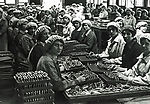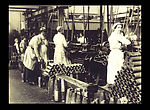Unemployment amongst women at the beginning of the war was very high. Already three times as great as unemployment amongst men, it was further exacerbated by the dislocation of women, who worked in the luxury trades. Queen Mary, consort of King George V, established a fund for women, the object of which was to provide employment for those thrown out of work by the war. Mary Macarthur became the Honorary Secretary of the Central Committee for Women's Employment, set up to administer the fund, which established a string of workshops, providing over 9000 jobs for unemployed women. It was at this time that Mary established a close working relationship with Queen Mary. She was the only woman to serve on the Emergency Workers National Committee, whilst also continuing her work with the Women's Trade Union League and National Federation of Women Workers.
Mary soon discovered that the challenge was not only to find employment for women, but also to overcome a great deal of prejudice. Working class women often faced severe financial hardship when their men went to war. They received a separation allowance, but this was so meagre that it did not compensate for the loss of earnings. Attempts to increase and diversify female employment were slow and the government showed little interest in the subject. It can be seen from the newspaper cuttings that, although appeals were made to women to come forward to release men for military service, many employers refused to take them.
In May 1915, however, news that the troops were short of high explosives shocked the country. A Ministry of Munitions was set up, headed by Lloyd George. He quickly brought most munitions under state control. With a need to increase production, the employment of women was now positively encouraged. Later, when compulsory male conscription was introduced, restrictions that had denied women access to particular trades were swept aside. Unemployment ceased to be the main concern. Mary turned her attention to the appalling conditions under which many of the women worked, and campaigned for equal pay for equal work. She urged the women to join appropriate unions.
In passing legislation to allow women into men's jobs, the Government failed to lay down any clear rules on pay. Employers were left with a practically free hand to set rates of pay and they fixed them very low. The largest numbers of women, and those most in the public eye, were employed on the making of munitions. The work was extremely hazardous. Factory explosions, sometimes causing fatalities, were not uncommon and workers' hands and faces turned yellow through handling TNT. The munitions girls became known as "canaries". Other symptoms included coughing, swelling, burns and skin eruptions.
Mary was aware of the damage that could be done if employers were allowed to get away with paying women poor wages. Apart from it being unfair, there was a danger that those jobs promised to men when they returned from the war would no longer be there, and that the pay levels fought for by the unions over the years would be eroded. Mary "saw from the start that the future interests of men and women ran together, and she was at least as keen on justice for men as on justice for women." (Hamilton, 1925,)
Mary also recognised that the Munitions Act of 1915, which had in many ways made the women's position worse, could work to their advantage. Strikes were forbidden. More startling, the Leaving Certificate Clause made it practically impossible for a worker on any form of munitions work to leave a job, no matter what the conditions or pay. Any worker attempting to leave without the required certificate of discharge from the employer, could be called before a special tribunal and punished. For example, a woman earning 10 shillings a week (50p) was refused a certificate by her employer to transfer to another munitions job at 17 shillings (85p), and the tribunal upheld the employer. Mary's argument was that, under the Munitions Act, the Government was responsible for conditions in munitions firms and so, if women were not allowed to leave their employment, then the Government had an obligation to make the conditions of employment decent.
Mary put this single point to Lloyd George, over and over again. There was no way round it, she stuck to this point with bulldog tenacity. "In articles, in interviews, in conference, on deputations, she drove it home, in its deadly simplicity. She refused to allow herself to be drawn off into side issues or to allow him to escape on to them. " (Hamilton, 1925)
Special Arbitration Tribunals had been set up under the Munitions Act and, for the next three years, Mary and her colleagues took many cases to them. On one occasion, employers, including the Admiralty, refused to pay rates that had been laid down by the Labour Supply Committee. Mary demanded arbitration on behalf of the Glasgow shell makers. Time passed and no action was taken. Arbitration had not been granted within the fixed period. This was the only condition under the Munitions Act where strike action was permitted. Susan Lawrence went to Glasgow as Mary's emissary. She held meetings with the workers, who gave a week's notice of their intention to strike. Within a week the employers paid up.
On a further occasion, a Munitions Tribunal agreed an increase in wages for 8,000 women workers in Newcastle. Week after week the firm was not given authority to pay. One morning Mary was telephoned by a furious Winston Churchill, the then Minister of Munitions, demanding to know why she was allowing the women to stop work. Mary answered that the women had waited patiently for the wages awarded to them three months ago. She had not advised them to come out, and she would not advise them to go back until the firm was instructed not only to pay the rate, but promptly to give them their back-pay. It was a stay-in strike, and the women sat on their seats by the machines, knitting socks for soldiers. Within twenty-four hours authorisation to pay the rates came to the firm and work resumed.
The position of working women during the war had been improved through the efforts of Mary Macarthur and people like her, although women's wages remained less than men's. Female trade union membership had increased from 357,000 in 1914 to over a million by 1918. Women aged 30 and over were given the vote and were allowed, for the first time, to stand for Parliament. Although exhausted by the demands of the war, this was Mary's next challenge. She was adopted as the Labour Party candidate for Stourbridge for the 1918 general election.
Rollover the captions in the box to see the available images in thumbnail format, click the caption to see the full-size image
| Reference: | 712 |
| Keywords: | |
| Archive Ref: | |
| Updated: | Wed 11 Jul 2007 - 1 |
| Interpretation written by | Barbara Harris |
| Author's organisation | |
| Organisation's website |


